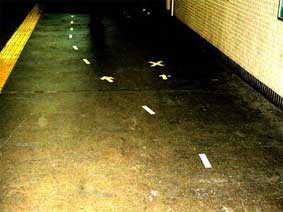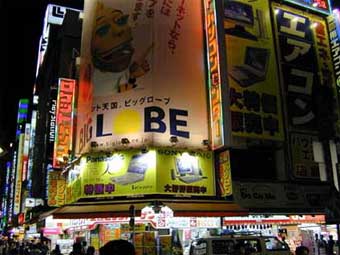skip to main |
skip to sidebar
 if someone is going blind, i'd recommend the person to move to tokyo. here in tokyo city, we can find the relief texture (braille) on walkways, public phones, cans of beer, subway ticket machines, etc., etc. furthermore, in the picture, they also have street crossing signal for the blinds, the white one. but i just wonder how the blind people know which the white one is. i guess it's more for us to press for them.
if someone is going blind, i'd recommend the person to move to tokyo. here in tokyo city, we can find the relief texture (braille) on walkways, public phones, cans of beer, subway ticket machines, etc., etc. furthermore, in the picture, they also have street crossing signal for the blinds, the white one. but i just wonder how the blind people know which the white one is. i guess it's more for us to press for them.
 in the midst of chaotic flow of tokyo's inhabitants, there is a group of people who walk in gridiron pattern. yes, the blinds. lucky for these people who rely on this cartesian geometry. in japan, they are provided with relief walkway almost everywhere.
in the midst of chaotic flow of tokyo's inhabitants, there is a group of people who walk in gridiron pattern. yes, the blinds. lucky for these people who rely on this cartesian geometry. in japan, they are provided with relief walkway almost everywhere.
 by looking deep down under the chaotic surface of tokyo, some hidden orders or systems reveal. in bangkok we drive on the left but are forced to walk on the right. these two things are tally in tokyo. have you ever experienced difficulties in getting past some one walking from the other direction? strangely, the two always take the same side and struggle hard to get past each other. this won't happen if they have the same system. collision could be avoided if they both take, for example, their own left.
by looking deep down under the chaotic surface of tokyo, some hidden orders or systems reveal. in bangkok we drive on the left but are forced to walk on the right. these two things are tally in tokyo. have you ever experienced difficulties in getting past some one walking from the other direction? strangely, the two always take the same side and struggle hard to get past each other. this won't happen if they have the same system. collision could be avoided if they both take, for example, their own left.
 the high density of people at hachiko's crossing made me more curious so i went there again on a rainy day to see how it's going to be. it looked like colour dots moving in interesting patterns. the space occupied by one person was increased by the size of his or her own umbrella. how could they manage the traffic?
the high density of people at hachiko's crossing made me more curious so i went there again on a rainy day to see how it's going to be. it looked like colour dots moving in interesting patterns. the space occupied by one person was increased by the size of his or her own umbrella. how could they manage the traffic?
 this is hachiko's crossing at shibuya. the number of passers-by is more than thousand of thousand each day. if you want to experience tokyo's chaos, come to this crossing and try walking among the crowd. you will find people in every square-meter moving in every direction. have a nice time!
this is hachiko's crossing at shibuya. the number of passers-by is more than thousand of thousand each day. if you want to experience tokyo's chaos, come to this crossing and try walking among the crowd. you will find people in every square-meter moving in every direction. have a nice time!
 similar to most modernised cities, tokyo city today is a concrete forest compounded with non-traditional architectures. however, sometimes we can find some paradoxical urban scenes such as an old traditional house between modern hi-rise towers or even a crazy, hi-tech looking architecture like this sitting next to a small house.
similar to most modernised cities, tokyo city today is a concrete forest compounded with non-traditional architectures. however, sometimes we can find some paradoxical urban scenes such as an old traditional house between modern hi-rise towers or even a crazy, hi-tech looking architecture like this sitting next to a small house.
 take a look closer, this building is not a new design from toyo ito. it's a building under construction with wrapped skin for safety protection. this quality of neatness is the typical characteristic of construction site in tokyo.
take a look closer, this building is not a new design from toyo ito. it's a building under construction with wrapped skin for safety protection. this quality of neatness is the typical characteristic of construction site in tokyo.
 the japanese-architecture maniacs who love the use of transparent or translucent materials of ito-san or hasegawa-san must be surprised with this another kind of transparency found abundantly in tokyo, especially during economic bubble period.
the japanese-architecture maniacs who love the use of transparent or translucent materials of ito-san or hasegawa-san must be surprised with this another kind of transparency found abundantly in tokyo, especially during economic bubble period.
 the structure of today tokyo is composed of many centers along an important train loop yamanote line - shibuya and harajuku for teens, shinjuku for business, akihabara for electrical equipments, for example. strange but true, the center of the loop is blank. the center of tokyo is empty! the area used to be castle and palace for the tokugawa shoguns in edo period and still remain as the palace for the royal family nowadays.
the structure of today tokyo is composed of many centers along an important train loop yamanote line - shibuya and harajuku for teens, shinjuku for business, akihabara for electrical equipments, for example. strange but true, the center of the loop is blank. the center of tokyo is empty! the area used to be castle and palace for the tokugawa shoguns in edo period and still remain as the palace for the royal family nowadays.
 in tokyo, each building stands individually with gaps in-between them. these gaps are varied in size. prof. hidetoshi ohno explains that these gaps prevent buildings from spreading structural collapse in earthquake and also accommodate electrical and air-conditioning systems.
in tokyo, each building stands individually with gaps in-between them. these gaps are varied in size. prof. hidetoshi ohno explains that these gaps prevent buildings from spreading structural collapse in earthquake and also accommodate electrical and air-conditioning systems.
 the japanese law says if you want to buy a car, you need to show an evidence or to prove that you have space to park it. this matter is related to urban planning, in order to limit the number of cars. sometimes the space provided is not quite enough.
the japanese law says if you want to buy a car, you need to show an evidence or to prove that you have space to park it. this matter is related to urban planning, in order to limit the number of cars. sometimes the space provided is not quite enough.
 this is a bird-eye view of shinjuku at night. sometimes we can evaluate the density level of a metropolis from these scattering red spots. this nighttime urbanscape is merely found in cbd of big cities, not in small towns or countrysides.
this is a bird-eye view of shinjuku at night. sometimes we can evaluate the density level of a metropolis from these scattering red spots. this nighttime urbanscape is merely found in cbd of big cities, not in small towns or countrysides.
 if manhattan's architectures are a paradigm for exploitation of congestion, according to koolhaas, the accumulation of tokyo's architecture is another kind of culture of congestion. modern city of tokyo is growing at incredible rate. spaces are needed more and more for a gigantic number of population.
if manhattan's architectures are a paradigm for exploitation of congestion, according to koolhaas, the accumulation of tokyo's architecture is another kind of culture of congestion. modern city of tokyo is growing at incredible rate. spaces are needed more and more for a gigantic number of population.
 the nearer you move to city center, the higher density of sign number is. somewhere, right in the center, it seemd urban space is formed just by this stream of signs. especially in akihabara where it is famous for electrical appliances. in some shops, almost every square-inch is dedicated to price lists and commercial signs. should we call this 'signtecture'?
the nearer you move to city center, the higher density of sign number is. somewhere, right in the center, it seemd urban space is formed just by this stream of signs. especially in akihabara where it is famous for electrical appliances. in some shops, almost every square-inch is dedicated to price lists and commercial signs. should we call this 'signtecture'?
 tokyo at first glance was like what roland barthes says in his book. it is the 'empire of signs'. it really is. public space fully flooded with signs is a typical scene of contemporary city nodes in japan. this is an exact image of japanese urban landscape
tokyo at first glance was like what roland barthes says in his book. it is the 'empire of signs'. it really is. public space fully flooded with signs is a typical scene of contemporary city nodes in japan. this is an exact image of japanese urban landscape















